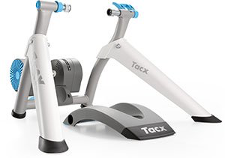Five Things to Know Before Buying a Road Bike Roller
Bike rollers allow you to train safely in all weather conditions, giving you the convenience of being able to train regardless of the circumstance.
If you want to buy a roller for your racing bike, you will find yourself faced with lots of choices. Obviously, for those who have no experience, this can be overwhelming. In this article, we want to give you some tips to help you understand the main differences between the bike rollers and what are the most important aspects to consider.
1. Types of roller and mechanics
First of all, it is necessary to identify which type of roller is the most suitable for your needs. There are three types of training rollers that differ in mechanics and how they are used:
Rear resistance rollers
With a rear resistance roller, the bike is locked on a stand and the rear wheel rests on a roller.

Roller
This traditional type of bike roller has three cylinders on which the bike rests. With this type of roller, the cyclisthave to balance while pedaling, just like when they are on the road.

Direct-drive rollers
The direct-driver roller functions without a rear wheel, which provides more accuracy and often more power.

Each of these rollers has their own strengths and weaknesses.
| ADVANTAGES | DISADVANTAGES | |
| Rear resistance roller | The initial setup is very fast. | A little noisier, especially when compared to a direct-drive roller. |
| Roller (Traditional) | The bike is free to move sideways just like on the road. | Some initial difficulty in use. |
| Direct-drive | This bike is silent, has better pedaling sensation and greater power. | Requires removal of the rear wheel. |
2. Receiving data, sending data and interactivity
Another fundamental factor for choosing bike rollers is the ability of the roller to send and receive data and being able to change the resistanceautomatically. Therefore, we can divide the rollers into 3 categories:
- Smart rollers
Inside they have sensors that measure and send training data (normally power, cadence and speed). This data can be viewed with different devices and with different programs. - Interactive rollers
They have all the functionality of the smart rollers, but the devices used to display the data (normally a smartphone, tablet or PC) can send instructions to the roller for a correct simulation or execution of a pre-established training program. - Mechanical
Mechanical rollers can be used for training, but do not measure training data.
If you are looking for training data to get more out of your workouts, a smart roller could be the answer. With smart rollers, you can combine speed and cadence sensors to unlock metrics such as rotations per minute (rpm), distance, and speed.
Smart rollers can also be used in combination with the various simulation programs by displaying your training data on the screen. Unfortunately, these programs, apps and peripherals can’t control the roller brake. Therefore, it is the cyclist who increases or decreases endurance and speed with smart rollers.
The roller that allows greater involvement and makes training more enjoyable is interactive rollers. As you know, indoor training is rather monotonous, but pedaling indoors can be fun with the right roller. The interactive rollers allow you to reproduce race and training courses and compete with yourself or with others, thanks to virtual simulations.
In fact, there are many simulation programs, apps, and peripherals on the market that provide a virtual experience for cyclists. Most of them, however, perform best only if connected with an interactive roller. Thanks to being able to control the roller brake, the programs can simulate a route and develop training programs in a much more complete way.
The interactive rollers are also compatible with the Garmin Edge wireless bike computers that have BLUETOOTH or ANT + connectivity. You can use your Edge in parallel with your favorite simulation app to download the indoor activity on Garmin Connect to make your ride feel like a real road trip, with a drop in altitude and data recorded by the sensors.
Obviously, for those who are not interested in the data, there are traditional rollers. These are rollersthat easily allow indoor pedaling sessions, but they do not measure and or send data. For this reason, the use of these reels is more tedious, although it is always possible to get distracted by listening to music or watching television.
Unfortunately, to date, it is not possible to convert a traditional roller into an interactive one. It is something to keep in mind before making a purchase.
3. Maximum simulated slope on the rollers
When choosing a roller, it is important to also consider the type of training that you want to do. If you plan to do maintenance training or agile work, then the roller does not need to have high braking capacity. If you want to do SFR (climb, strength and endurance), then it is ideal for the roller to be able to create sufficient resistance.
A…
